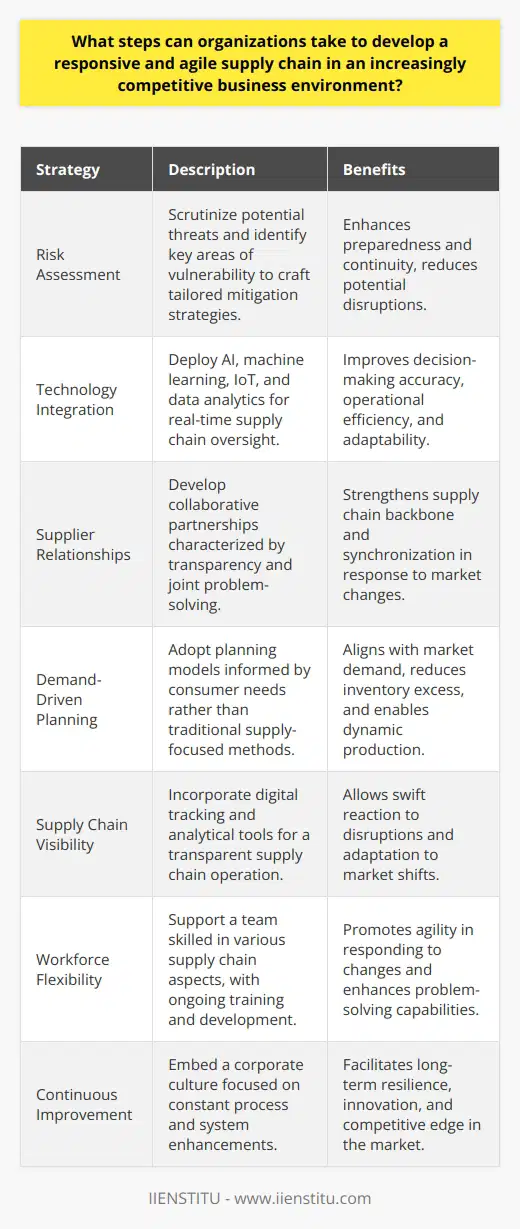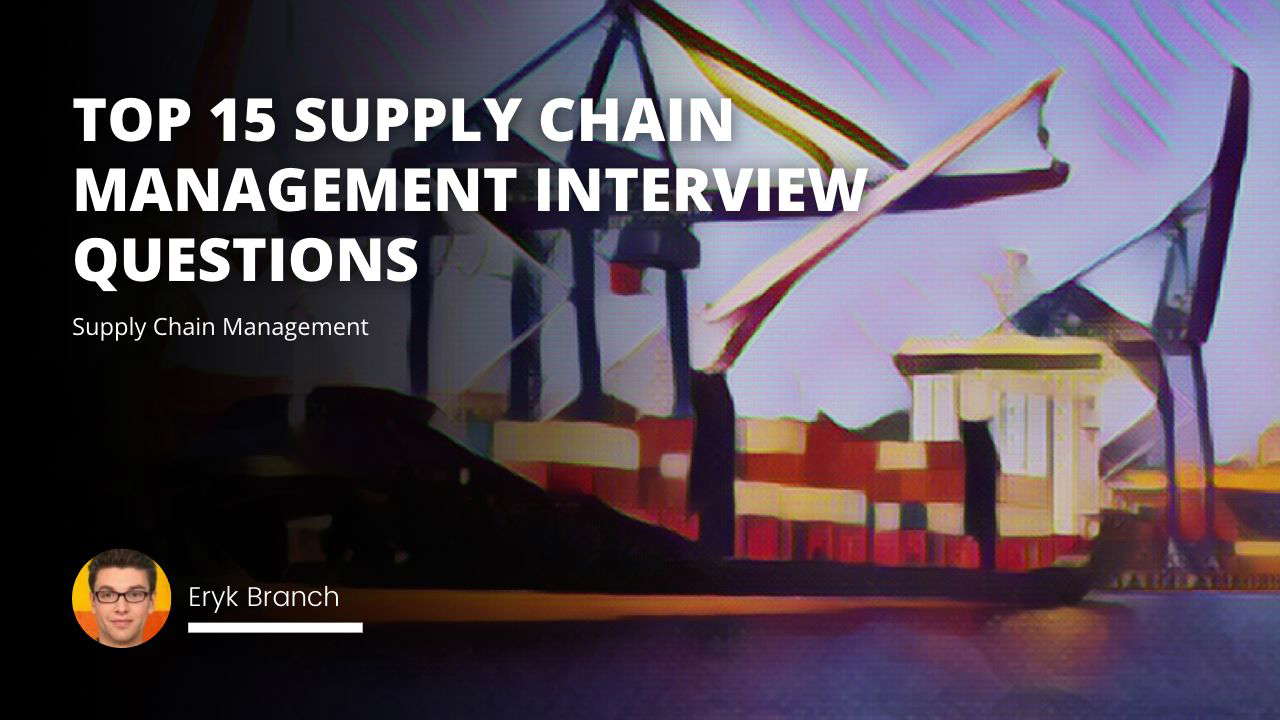
In today’s competitive business environment, organizations must optimize their supply chain to maximize efficiency. Supply chain optimization is the process of improving the overall performance of the supply chain by analyzing, managing, and improving each of its individual components.
This includes identifying potential risks and opportunities, assessing current processes and resources, and implementing changes to ensure that the supply chain is meeting customer demands. Supply chain optimization is essential for businesses looking to stay ahead of the competition and remain profitable in the long run.
By optimizing their supply chain, organizations can reduce costs, improve customer service, and increase overall efficiency. In this blog post, we will discuss the key strategies for optimizing your supply chain for maximum efficiency.
Analyzing Your Supply Chain
Identifying Risks and Opportunities
Assessing Current Processes and Resources
Implementing Changes to Optimize the Supply Chain
Measuring the Impact of Optimization
Analyzing Your Supply Chain
The subject of optimizing your supply chain for maximum efficiency is a complex one, and involves analyzing your supply chain, identifying risks and opportunities, assessing current processes and resources, implementing changes to optimize the supply chain, and measuring the impact of optimization.
By taking the time to analyze your supply chain, you can identify potential risks and opportunities, and assess the current processes and resources available to you. Once you have identified potential risks and opportunities, you can then implement changes to optimize the supply chain. Finally, you can measure the impact of optimization to ensure that the changes are effective and that the supply chain is operating efficiently.
Identifying Risks and Opportunities
Identifying risks and opportunities is an essential step in optimizing your supply chain for maximum efficiency. It involves taking a close look at the current processes and resources within the supply chain, and assessing any potential risks or opportunities that may exist.
This includes analyzing the current structure of the supply chain, and identifying any areas that may be underperforming or inefficient. By doing this, you can identify areas where improvements can be made, and develop strategies to mitigate any potential risks.
Additionally, you can also identify any potential opportunities that can be leveraged to improve supply chain performance. This step is critical for ensuring that any changes implemented to optimize the supply chain are effective, and can be measured for their impact.
Assessing Current Processes and Resources
In order to optimize the supply chain for maximum efficiency, it is important to assess the current processes and resources. This includes analyzing the current supply chain, identifying any risks or opportunities, and assessing the resources available.
İnterview Question Efficient Supply Chain Key Components Explanation
Value-added Logistics Services İmpact On Business Efficiency
In addition to this, it is important to consider the impact that any changes implemented to optimize the supply chain will have. This will help to ensure that the changes implemented are effective and will lead to maximum efficiency.
Implementing Changes to Optimize the Supply Chain
Optimizing your supply chain for maximum efficiency requires a comprehensive approach that includes analyzing your current supply chain, identifying risks and opportunities for improvement, assessing current processes and resources, and implementing changes to optimize the supply chain.
Implementing changes to optimize the supply chain is a critical step in the optimization process and should be done with careful consideration.
Changes should be tailored to the specific needs of the organization, and should be implemented in a way that is cost-effective and sustainable. It is important to consider the impact of the changes on the entire supply chain, and to measure the results of the optimization efforts to ensure that the changes are having the desired effect.
Measuring the Impact of Optimization
Measuring the Impact of Optimization is a critical step in the process of optimizing a supply chain for maximum efficiency. This involves analyzing the changes that have been made to the supply chain, assessing the impact of those changes, and then determining whether further optimization is necessary.
By evaluating the success of the changes implemented, businesses can ensure that their supply chain is operating at its peak efficiency. Additionally, measuring the impact of optimization can help to identify areas of improvement and areas where further optimization may be necessary. By taking the time to measure the impact of optimization, businesses can ensure that their supply chain is optimized for maximum efficiency.
The key to success lies in optimizing your supply chain for maximum efficiency.

The given text details about how businesses can optimize their supply chain for maximum efficiency. It emphasizes on several key strategies such as analyzing the current supply chain, identifying potential risks and opportunities, assessing existing resources and processes, implementing necessary changes, and measuring the impact of these changes. The document asserts that tapping into opportunities and mitigating risks can result in cost reduction and service improvement, eventually elevating overall efficiency. Measuring the impact post-implementation ensures that the supply chain operates effectively. The emphasis on the value of evaluating supply chain management mirrors the importance of supply chain management courses free, which could provide insight into practical optimization strategies.
Frequently Asked Questions
How do you optimize supply chain efficiency?
Optimizing Supply Chain Efficiency: Key Methods
One method for optimizing supply chain efficiency is implementing technology solutions such as warehouse automation, artificial intelligence (AI), and data analytics. Warehouse automation enables managers to streamline operations, reduce human error, and increase speed, all of which contribute to a more efficient supply chain. AI can enhance decision-making through better forecasting and proactive actions, while data analytics can offer insights into supplier performance and improve inventory management.
Effective Inventory Management: An Essential Component
Another crucial aspect of optimizing supply chain efficiency is effective inventory management. By employing strategies such as just-in-time (JIT) inventory, cross-docking, and demand planning, companies can align inventory levels with real-time customer demand. This approach minimizes the risk of stockouts and overstocking, lowers carrying costs, and promotes overall supply chain agility. Utilizing real-time tracking and monitoring systems can further enhance visibility and improve the overall efficiency of inventory management processes.
Enhanced Supplier Relationship Management: Strengthening the Chain
Maintaining strong supplier relationships is key to supply chain optimization. Collaborative forecasting, supplier performance measurement, and regular communication can foster positive trading partnerships, mitigate risks, and improve supply continuity. Companies should also perform regular audits and assess suppliers' financial stability to ensure that they can consistently deliver on their commitments. By building trust and transparency in the supplier network, organizations can achieve better overall performance and enhance their supply chain efficiency.
Lean Principles: Reducing Waste and Boosting Efficiency
Lean principles, which focus on reducing waste and non-value-adding processes, can be applied to achieve supply chain efficiency. Examples of such principles include continuous improvement, pull-based systems, and minimizing lead time variability. By analyzing processes and implementing these principles, companies can systematically eliminate inefficiencies, lower costs, and increase throughput. This approach results in a more streamlined and agile supply chain, better prepared to respond to market fluctuations.
Integrating Supply Chain Functions: Boosting Synergy and Coordination
Lastly, the integration of supply chain functions such as procurement, manufacturing, logistics, and demand planning promotes a more holistic view of the organization, fostering increased collaboration and coordination. This integrated approach enables better decision-making, supports the execution of cross-functional improvements, and reduces lead times. Ultimately, a well-aligned supply chain drives higher levels of efficiency, resilience, and effectiveness, enhancing overall business performance.
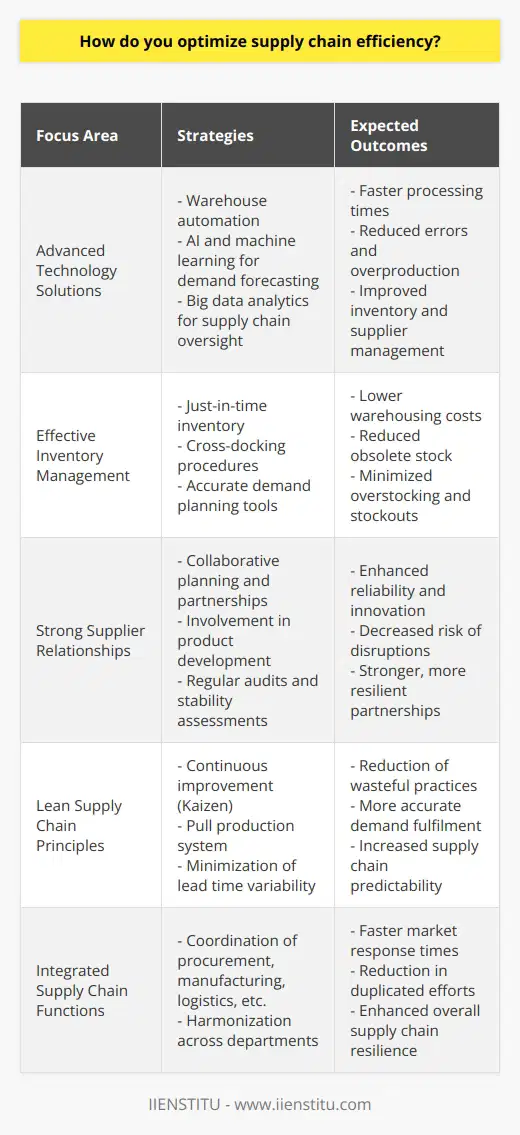
What is optimization in supply chain management?
Optimization in Supply Chain Management
Concept and Importance
Optimization in supply chain management (SCM) is the process of refining various parameters and processes to improve the overall efficiency, reduce operational costs, and enhance customer satisfaction. The primary goal is to identify bottlenecks, eliminate waste, and streamline operations within the supply chain to ensure a smooth flow of goods and services from the suppliers to the customers.
Techniques and Strategies
Various techniques and strategies can be employed to optimize the supply chain. These include efficient inventory management, demand forecasting, supplier relationship management, real-time data analysis, and collaboration among various stakeholders, such as suppliers, manufacturers, and retailers, to ensure the seamless execution of tasks. Moreover, technological advancements, such as artificial intelligence (AI), machine learning, and the Internet of Things (IoT), further enable SCM optimization by providing real-time data, automation, and improved decision-making capabilities.
Balancing Cost and Service Levels
One critical aspect of optimization in SCM is striking the right balance between cost reduction and maintaining high service levels. Organizations must comprehensively assess their supply chain processes to identify areas of inefficiency and wastage. However, it is crucial to ensure that cost-cutting measures align with the organization's objectives and do not result in compromised service quality. For instance, reducing inventory levels may lower operational costs but can hamper an organization's ability to meet customers' demands if not properly managed.
Sustainability and Risk Management
Apart from cost-effectiveness, optimization in SCM also involves considering sustainability and risk management. Sustainable supply chain practices promote the responsible and eco-friendly use of resources, minimize waste and pollution, and contribute to long-term organizational success. Furthermore, effective risk management strategies, such as improved supplier selection, robust contingency planning, and agile response mechanisms, help businesses navigate disruptions, and uncertainties in their supply chains, thereby ensuring smooth operations and customer satisfaction.
Continuous Improvement
At its core, optimization in SCM is a continuous improvement process that necessitates monitoring, evaluation, adjustment, and re-alignment of processes and strategies according to changes in the business environment, customer demands, and emerging technologies. In essence, optimization in supply chain management is a vital aspect for any business endeavoring to maintain a competitive edge by maximizing operational efficiency, enhancing customer satisfaction, and ensuring long-term growth and sustainability.
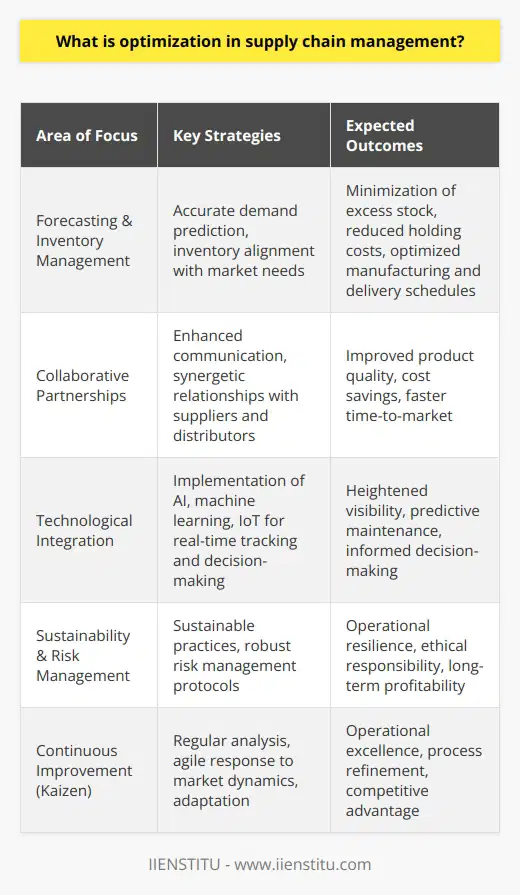
How do you maximize supply chain?
Optimizing Supply Chain Components
To maximize a supply chain, one must first focus on optimizing its various components. This includes assessing the efficiency of suppliers, manufacturers, distribution centers, and retailers. By ensuring that every element of the chain is functioning at its highest level, it is possible to increase overall performance and responsiveness.
Leveraging Technology and Data
Another critical component in maximizing the supply chain is leveraging technology and data. By utilizing state-of-the-art software and automated processes, companies can more accurately track inventory, analyze demand patterns, and forecast future trends. This valuable insight enables businesses to make informed decisions regarding procurement and production levels, ultimately resulting in reduced lead times and increased efficiency.
Establishing Strong Partnerships
Developing strong partnerships with suppliers and other vendors is essential for maximizing the supply chain. By fostering relationships built on trust and collaboration, companies can better align their goals, share resources, and ensure a seamless flow of products throughout the chain. This collaborative approach creates a more flexible, responsive supply chain that can better adapt to fluctuations in demand and market conditions.
Implementing Lean Practices
Maximizing supply chain efficiency often involves implementing lean practices, which focus on reducing waste and unnecessary processes. These methods aim to streamline operations, minimize handling time, and optimize resources. When effectively applied, these measures can lead to significant cost and time savings, increased product quality, and improved customer satisfaction.
Enhancing Visibility and Communication
Lastly, it is crucial to enhance visibility and communication throughout the supply chain. This can be achieved through regular meetings, performance reporting, and the use of collaborative tools. By fostering open lines of communication, businesses can more effectively coordinate efforts, address issues promptly, and maintain a high level of transparency. This ultimately contributes to a more efficient and dynamic supply chain that can readily respond to market changes.
In conclusion, maximizing the supply chain involves a comprehensive approach that addresses various aspects like optimization of components, leveraging technology and data, establishing strong partnerships, implementing lean practices, and enhancing visibility and communication. By focusing on these key areas, businesses can create a more agile, efficient, and responsive supply chain capable of adapting to shifts in demand and the ever-evolving market landscape.
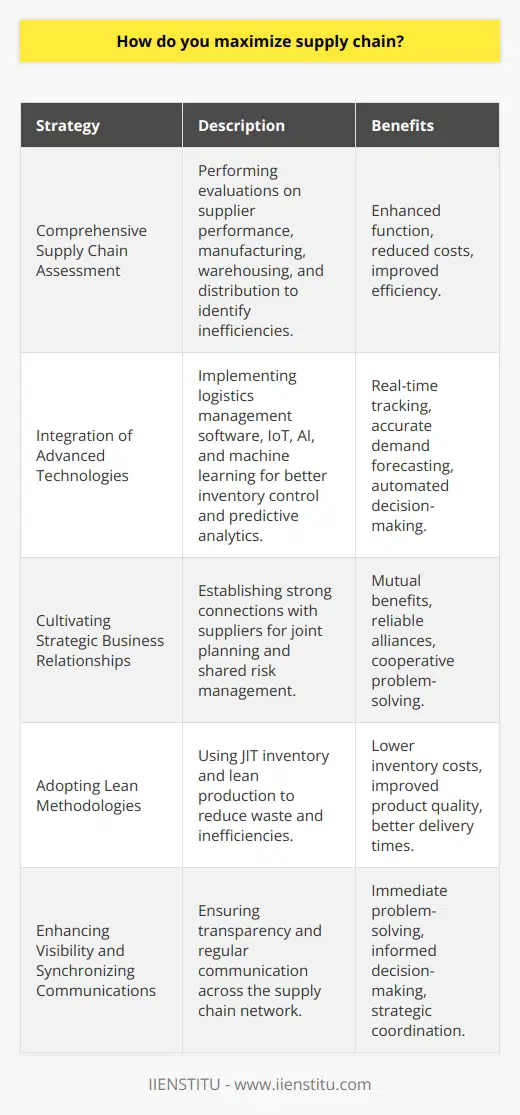
What factors contribute to an efficient and optimized supply chain?
Factors Contributing to Supply Chain Efficiency
Strategic Planning and Network Design
An optimized supply chain starts with effective strategic planning that encompasses the entire network, considering both external factors and internal capabilities. This involves analyzing with a holistic vision the procurement, production, transportation, and distribution of products and implementing appropriate plans to streamline these activities.
Technological Innovations
Advancements in technology contribute to supply chain efficiency by automating various processes, reducing human error, and providing real-time data for informed decision-making. Key technologies, such as Enterprise Resource Planning (ERP) systems, Internet of Things (IoT), and warehouse robotics, play a vital role in connecting and optimizing different components of the supply chain.
Data-driven Decision-making
Accurate data and analytics provide insights for managers to make informed decisions that boost efficiency in the supply chain. Data-driven decisions, such as inventory optimization, demand forecasting, and risk management, can help in reducing uncertainties and minimize costs while improving customer satisfaction.
Supply Chain Collaboration
Collaboration with suppliers, partners, and customers allows for information sharing which can lead to improved efficiency in the supply chain. Through this collaborative approach, organizations can better anticipate and respond to market changes, reducing lead times and maintaining a flexible supply chain.
Lean Management Principles
Lean management emphasizes the reduction of waste and inefficiencies in the supply chain. By identifying and eliminating non-value-added activities, establishing efficient processes, and continuously seeking improvement, organizations can achieve an optimized and cost-effective supply chain.
Agile Supply Chain Strategies
Adapting agile strategies in the supply chain fosters an organization's ability to respond to changing customer needs and market dynamics. Agile supply chains prioritize flexibility and adaptability over cost-efficiency, making them better equipped to handle disruptions and changes in consumer preferences.
Risk Management and Contingency Planning
Proactive risk management and the development of contingency plans for potential disruptions contribute to supply chain efficiency. Identifying potential risks, such as supplier disruptions or market fluctuations, allows organizations to mitigate their impact and minimize associated costs.
In conclusion, achieving an efficient and optimized supply chain requires a combination of strategic planning, technology, data-driven decision-making, collaboration, lean management principles, agile strategies, and risk management. These factors, along with effective execution, can lead to a robust, flexible, and cost-effective supply chain that benefits both the organization and its customers.
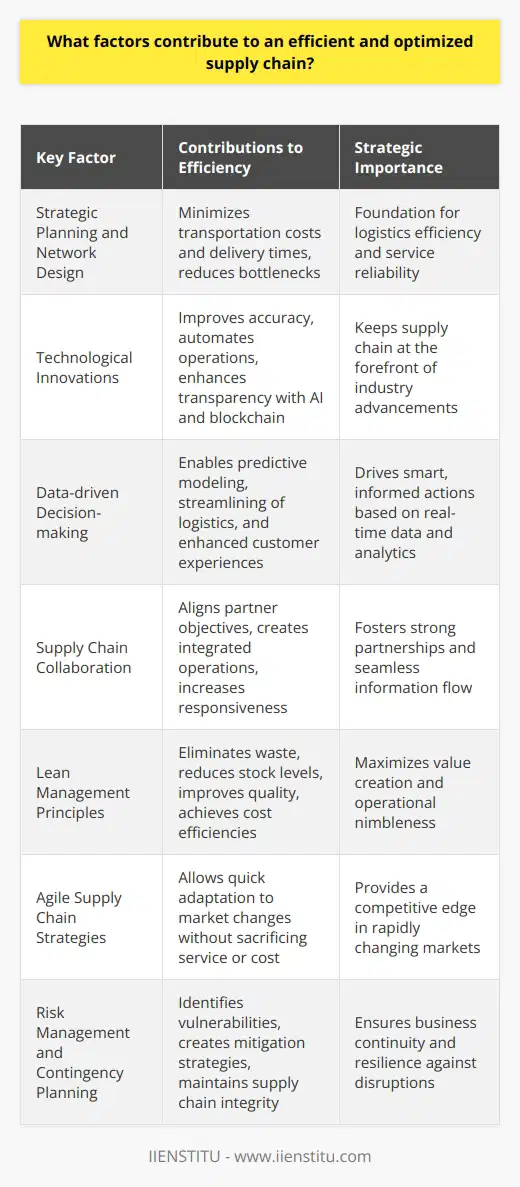
How can technology and data analytics improve supply chain optimization?
Leveraging Analytics for Enhanced Efficiency
One way technology and data analytics can improve supply chain optimization is by enhancing efficiency. Advanced analytics tools can process enormous amounts of data, enabling organizations to identify bottlenecks, predict demand, and streamline their supply chain processes.
Monitoring Real-Time Data
Moreover, real-time data monitoring allows for agile responses to fluctuating market conditions. Managers can rapidly adjust production levels or change suppliers, based on current trends and demands, minimizing waste and maximizing customer satisfaction.
Optimizing Inventory Management
Technology and data analytics can also optimize inventory management, leading to reduced costs and capital commitments. By analyzing historical sales data and forecasting future demand, companies can better anticipate their inventory needs and allocate resources more effectively.
Improving Supplier Collaboration
Furthermore, strong supplier relationships are vital for supply chain success. Data analytics can improve these relationships by providing transparency and fostering collaboration. Sharing essential data facilitates improved communication and greater understanding of shared goals and challenges.
Addressing Risk Management
Lastly, risk management is a critical aspect of supply chain optimization. Data analytics can identify and assess potential risks, such as capacity constraints, supplier performance issues, and geopolitical concerns. Through risk evaluation and mitigation strategies, organizations can better safeguard their supply chains from disruptions.
In conclusion, technology and data analytics can significantly improve supply chain optimization by enhancing efficiency, enabling real-time data monitoring, streamlining inventory management, fostering supplier collaboration, and addressing risk management. Implementing these advanced tools can lead to more agile and resilient supply chains, ultimately providing a competitive advantage in today's global marketplace.
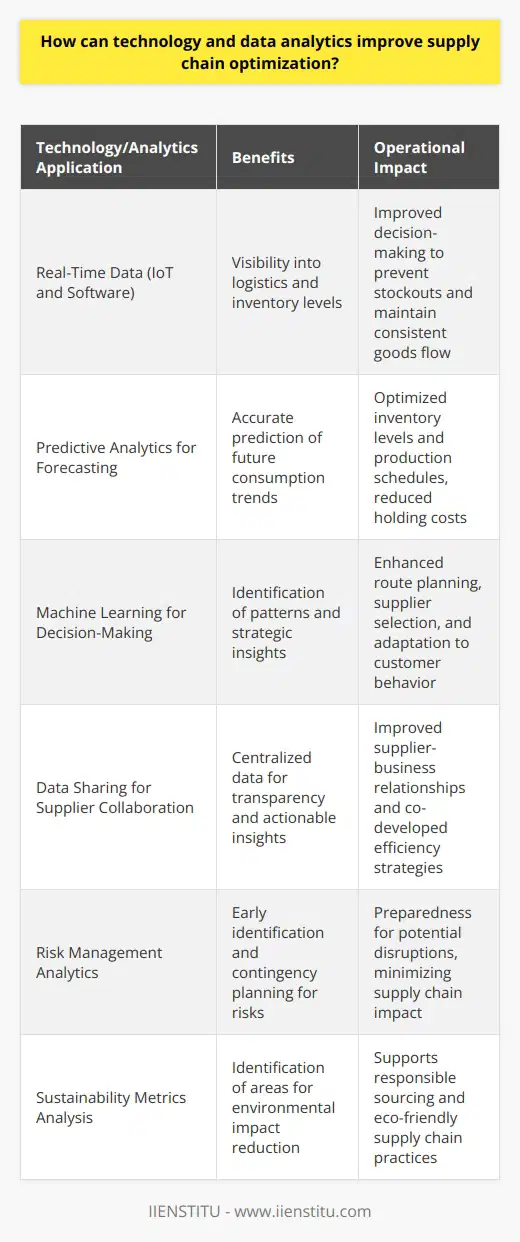
What role does demand forecasting play in developing effective supply chain strategies?
Role of Demand Forecasting in Strategy Creation
Demand forecasting significantly contributes to the development of effective supply chain strategies. It serves as the foundation for decision-making, allowing organizations to predict future consumer needs and appropriately allocate resources to meet them. By anticipating changes in demand, businesses can tailor their operations and resource allocation to align with market trends, enhancing efficiency, competitiveness, and profitability.
Influence on Inventory Management
Accurate demand forecasts enable optimization of inventory management, ensuring sufficient stock levels to meet customer expectations while avoiding overstocking costs. Demand forecasting allows companies to strike a balance between supply and demand, reducing inventory holding costs and the risk of stockouts. This results in improved customer satisfaction, operational efficiency, and cost savings.
Impact on Production Scheduling
Demand forecasts inform production planning, helping organizations determine appropriate production volumes, allocate resources, and schedule manufacturing activities. Accurate production scheduling based on forecasted demand minimizes waste, maximizes capacity utilization, and improves overall operational efficiency. Additionally, it allows businesses to adjust production levels based on demand fluctuations, promoting responsiveness and agility.
Collaboration with Suppliers
Demand forecasting facilitates better coordination with suppliers, allowing businesses to share information across the supply chain, improving collaboration and decision-making. Adequate forecasts empower companies to synchronize supply chain activities, fostering better supplier relationships and promoting a more efficient and effective supply chain. Consequently, it enhances the company's ability to adapt to changes in the marketplace, ensuring long-term competitiveness.
Risk Management and Mitigation
Contingency planning plays a vital role in supply chain management. Demand forecasting aids in identifying potential risks and predicting their impact on the supply chain, enabling organizations to take proactive measures to mitigate risks. This ability to foresee and manage potential disruptions in the supply chain fosters resilience, ensuring the continuous fulfillment of consumer demands.
In conclusion, demand forecasting plays a critical role in developing effective supply chain strategies. It influences inventory management, guides production scheduling, supports supplier collaboration, and improves risk management. By incorporating accurate demand forecasting into their supply chain strategies, businesses can enhance their operational efficiency, competitiveness, and profitability in the face of an ever-evolving marketplace.

How do you optimize supply chain efficiency?
Supply Chain Optimization Techniques
To optimize supply chain efficiency, several key strategies can be employed, including the enhancement of inventory management, streamlining transportation processes, fostering collaboration, and leveraging technology.
Effective Inventory Management
Effective inventory management is crucial to optimizing supply chain efficiency. Emphasis should be placed on the accurate forecasting of demand and monitoring of inventory levels. Implementing just-in-time (JIT) inventory systems can minimize costs associated with storage, spoilage, and obsolescence while ensuring the availability of products when needed.
Streamlined Transportation Processes
Improving transportation processes can significantly contribute to supply chain efficiency. Route planning that minimizes distance traveled, fuel consumption, and overall transportation costs can have a direct impact on the bottom line. Additionally, the consideration of alternative modes of transportation, such as rail or air, may provide cost-effective solutions depending on the specific product and destination.
Collaboration with Key Partners
Forging stronger relationships with suppliers, distributors, and other key partners can further optimize supply chain efficiency. Information sharing, joint planning, and synchronization of activities can lead to a seamless, cost-effective, and efficient supply chain process. Cross-organizational teams may be formed to tackle issues such as demand forecasting, risk mitigation, and best practices sharing.
Leveraging Technology and Analytics
Utilizing technology such as Enterprise Resource Planning (ERP) systems, Warehouse Management Systems (WMS), and Transportation Management Systems (TMS) can improve transparency, visibility, and control across the entire supply chain. Additionally, data analytics can provide insight into areas of improvement and facilitate informed decision-making. Predictive analytics can further aid organizations in anticipating disruptions, allowing for proactive management and mitigation of potential risks.
In conclusion, optimizing supply chain efficiency requires a careful balance of inventory management, transportation processes, collaboration, and technological investments. By implementing these practices, organizations can reduce costs, enhance customer satisfaction, and ultimately improve their competitive position in the market.

What are the key performance indicators to measure supply chain optimization?
Key Performance Indicators Overview
Key Performance Indicators (KPIs), are critical for assessing the performance and effectiveness of a supply chain. These KPIs provide insights into the overall efficiency, cost-effectiveness, and agility of the system, enabling managers to identify areas for improvement and strategic adjustments. This essay discusses four key performance indicators to measure supply chain optimization: order fulfillment, inventory turnover, total cost of ownership, and supply chain responsiveness.
Order Fulfillment
A crucial KPI for supply chain optimization is order fulfillment. Order fulfillment measures the percentage of orders that are processed, shipped, and delivered to customers on time and in full. High order fulfillment rates signify that a supply chain is functioning smoothly and meeting customer expectations. This indicator reflects the agility, reliability, and customer-centricity of the supply chain, as well as its overall efficiency in providing a seamless experience from order placement to delivery.
Inventory Turnover
Another vital KPI is inventory turnover. This metric represents how frequently inventory is sold and replenished during a specific period, typically a fiscal year. A higher inventory turnover rate indicates a more efficient supply chain, as it signifies the successful management of stock levels and adept adaptation to changes in market demands. By closely monitoring inventory turnover, supply chain managers can strike an optimal balance between minimizing inventory holding costs and ensuring timely product availability.
Total Cost of Ownership
The third indicator is the total cost of ownership (TCO). TCO encompasses all direct and indirect costs associated with the acquisition, transportation, storage, and disposal of materials throughout the supply chain. It is essential to consider both TCO's components: direct costs, such as raw material and manufacturing costs, and indirect costs, such as compliance, risk management, and administration. Supply chain optimization revolves around minimizing TCO while maintaining product quality and customer satisfaction, thus making TCO a critical KPI for evaluating overall supply chain efficiency.
Supply Chain Responsiveness
Lastly, supply chain responsiveness gauges how quickly a supply chain can adapt to changes in market conditions or customer demands. Responsiveness is particularly essential in industries characterized by rapid technological advances, shifting consumer preferences, or volatile commodities. Effective supply chains swiftly adjust their strategies by incorporating new suppliers, leveraging advanced forecasting techniques, and adopting flexible manufacturing processes. A high degree of supply chain responsiveness ensures timely product development, production, and delivery, contributing to a competitive advantage in the market.
Conclusion
In conclusion, the key performance indicators for measuring supply chain optimization include order fulfillment, inventory turnover, total cost of ownership, and supply chain responsiveness. Implementing these KPIs allows organizations to comprehensively evaluate their supply chains' performance and systematically identify critical areas for improvement. Continuous monitoring and management of these indicators will ensure robust and agile supply chains, leading to sustained business success.
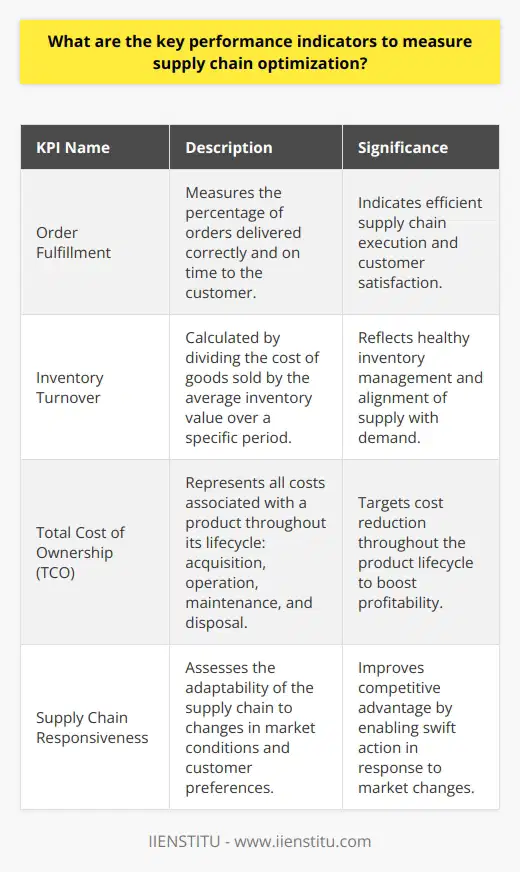
How can you maximize supply chain profitability?
Optimizing Inventory Management
To maximize supply chain profitability, businesses must optimize inventory management to reduce holding costs and to avoid stockouts. Implementing tracking systems and adopting demand forecasting techniques can provide accurate real-time data on available stock and future demand projections. This information allows businesses to make informed decisions on inventory levels, ensuring they have just the right amount of stock on hand.
Reducing Lead Times
Efficiently managing lead times can also increase supply chain profitability. Reducing lead times through supplier collaboration, agile processes, and effective communication can minimize potential disruptions and delays. By enhancing responsiveness and reliability, businesses can benefit from increased customer satisfaction, which in turn leads to higher sales and profitability.
Automation and Technology
Integrating automation and technology into supply chain processes helps in reducing manual errors, cutting costs, and maximizing efficiency. Businesses should consider investing in technological advancements, such as machine learning and artificial intelligence, to streamline operations and optimize decision-making. Digital solutions can also help to minimize administrative tasks and improve accuracy in demand forecasting, inventory management, and customer service.
Supplier Relationship Management
Establishing strong relationships with suppliers can contribute to supply chain profitability. Businesses should focus on maintaining transparent communication, engaging in collaborative problem-solving, and sharing resources to improve customer service, lower costs, and reduce risks within the supply chain. Cultivating mutually beneficial relationships with suppliers can contribute to long-term gains in efficiency, productivity, and profitability.
Lean Principles and Continuous Improvement
Adopting lean principles and focusing on continuous improvement can help businesses in maximizing supply chain profitability. A lean approach entails eliminating waste, prioritizing value-adding activities, and streamlining processes to improve efficiency. By implementing continuous improvement strategies, companies can consistently identify new opportunities for cost reduction and revenue enhancement.
In conclusion, maximizing supply chain profitability can be achieved through several strategic initiatives, including optimized inventory management, reduced lead times, automation and technology integration, strong supplier relationships, and adherence to lean principles. Focusing on efficiency, collaboration, and innovation can help businesses achieve long-term, sustainable growth within their supply chain operations.
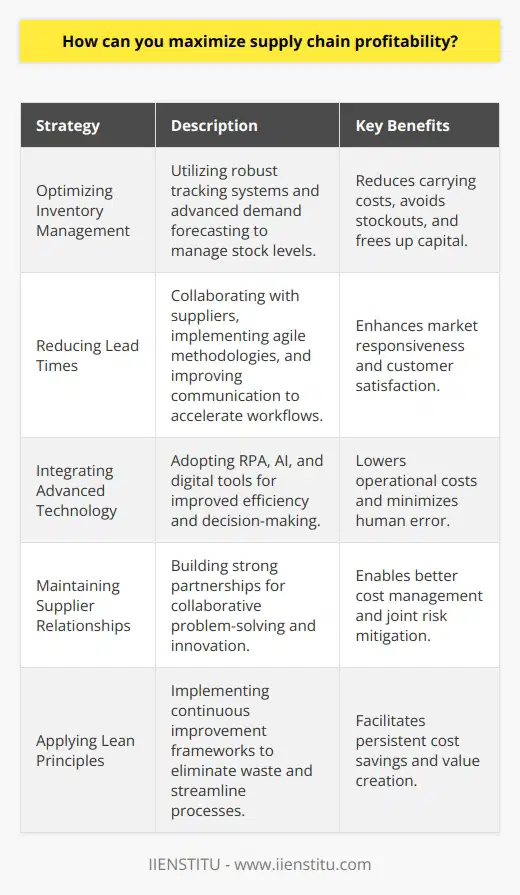
What are the best practices for achieving supply chain optimization?
Supply Chain Optimization Strategies
First and foremost, achieving supply chain optimization calls for integrated planning and execution. Organizations must establish a robust approach that brings together demand planning, supply planning, and production scheduling. This collaborative approach ensures stakeholders work together, leading to improved communication, coordination, and decision-making.
Digital Transformation
Incorporating latest technological advancements is crucial for a modern and efficient supply chain. Digital transformation entails adopting tools such as data analytics, machine learning, and cloud computing to enhance forecasting accuracy, optimize inventory levels, and reduce lead times. Additionally, digitization enables real-time data sharing and visibility into the entire network, promoting transparency and efficiency.
Risk Management and Resilience
Supply chain optimization is not complete without proactive risk management and resilience strategies. Resilient supply chains are capable of coping with disruptions and adapting to unforeseen events. Implementing measures such as supply chain mapping, risk assessment, dual sourcing, and supplier diversification help to mitigate the impact of disruptions and ensure business continuity.
Lean and Green Practices
Adopting lean and green practices can lead to significant improvements in operational efficiency and environmental sustainability. These practices encompass applying the lean management principles (e.g., reducing waste, continuous improvement) and integrating eco-friendly solutions (e.g., energy-efficient transportation, sustainable packaging materials). In turn, these practices decrease costs, minimize environmental impact, and enhance brand reputation.
Performance Measurement
Continuous monitoring and assessment of supply chain performance is essential for maintaining and refining optimization practices. Key Performance Indicators (KPIs) should be established to evaluate the effectiveness of various strategies and identify areas that require improvement. Performance data serves as a valuable feedback loop, enabling organizations to adjust and optimize their supply chains iteratively.
In conclusion, supply chain optimization requires a holistic approach encompassing integrated planning, digital transformation, risk management, lean and green practices, and performance measurement. These best practices combined create an optimized and resilient supply chain capable of driving organizational success and maintaining a competitive edge.
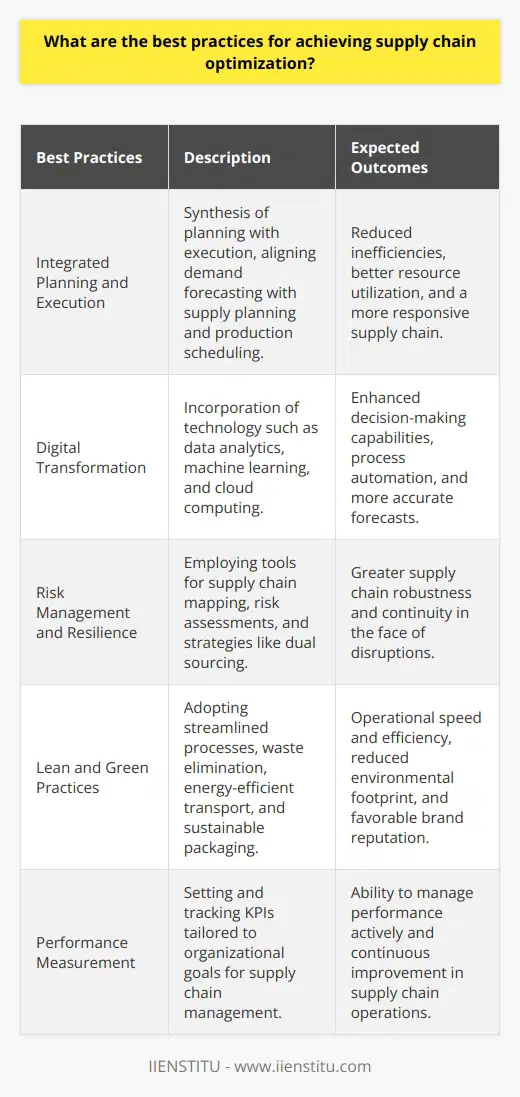
How does the integration of suppliers, manufacturers, and distributors impact supply chain efficiency?
Impact on Supply Chain Efficiency
The integration of suppliers, manufacturers, and distributors plays a crucial role in enhancing supply chain efficiency by streamlining processes, improving collaboration, and reducing costs. With a well-integrated system, organizations can achieve greater visibility, better decision-making, and more efficient allocation of resources.
Streamlined Processes
Integration facilitates more effective communication and coordination between supply chain partners, which enables businesses to implement streamlined processes across the entire supply chain. This results in minimized delays and disruptions, as well as faster movement of products from suppliers to distributors.
Improved Collaboration
Through enhanced information sharing, supply chain partners can more easily collaborate, leading to better forecasting of demand and inventory needs. This helps companies optimize their production schedules, reduce excess inventory, and avoid stock-outs, all of which contribute to increased supply chain efficiency.
Reduced Costs
An integrated supply chain allows for the sharing of resources and information, which can significantly reduce operational costs. By working together on transport, warehousing, and production, partners can identify and implement cost-savings measures to increase efficiency.
Greater Visibility
Integration provides a comprehensive view of the entire supply chain, enabling stakeholders to identify areas of potential improvement and adjust their processes accordingly. By monitoring inventory levels, lead times, and transportation information in real-time, organizations can proactively address potential issues before they escalate.
Better Decision-Making
With greater access to shared data and communication channels, supply chain partners can make more informed decisions. This supports continuous improvement efforts, as organizations can analyze historical data and develop action plans to increase efficiency and strategically invest in their supply chain capabilities.
Efficient Allocation of Resources
An integrated approach to supply chain management ensures that resources are used effectively, leading to reduced waste of materials, time, and labor. Efficient allocation of resources enables companies to fulfill customer demand in a timely manner, thereby maintaining high levels of customer satisfaction.
In conclusion, integrating suppliers, manufacturers, and distributors significantly impacts supply chain efficiency by enabling companies to create seamless processes, improve collaboration, and reduce associated costs. This ultimately leads to more sustainable business practices and a higher level of performance across the entire supply chain.

What are the potential benefits and challenges of implementing a sustainable supply chain strategy?
Potential Benefits of Sustainable Supply Chain Strategy
Enhanced Brand Reputation
Implementing a sustainable supply chain strategy can lead to an enhanced brand reputation, as companies demonstrate commitment to environmental and social responsibilities.
Cost Reduction
By optimizing resource usage and reducing waste, companies can achieve significant cost reductions in production, transportation, and disposal processes.
Risk Mitigation
A sustainable supply chain strategy enables companies to better anticipate and address environmental and social risks, thus minimizing potential disruptions and losses.
Competitive Advantage
Sustainable practices can lead to a competitive advantage, as customers increasingly demand products and services from companies that share their values.
Regulatory Compliance
Incorporating a sustainable supply chain strategy helps companies navigate and prepare for potential regulatory changes, minimizing the risk of noncompliance and potential fines.
Challenges in Implementing Sustainable Supply Chain Strategy
High Initial Costs
Investing in sustainable technologies and processes might require significant upfront costs, particularly for smaller businesses.
Complex Supply Chain Networks
It can be challenging to promote and maintain sustainability throughout complex global supply chains with multiple suppliers, manufacturers, and distributors.
Resistance to Change
Companies may face resistance from stakeholders who perceive sustainable practices as an unnecessary cost or an inconvenience, thus slowing down the implementation process.
Lack of Standardization
The absence of widely-adopted standards and guidelines for sustainable supply chain management may create confusion and lead to inconsistency in practices and reporting requirements.
Limited Resources and Expertise
Companies may need to invest in specialized knowledge and training to build the necessary skills and expertise to effectively implement a sustainable supply chain strategy.
In conclusion, implementing a sustainable supply chain strategy offers various potential benefits, such as cost reduction, risk mitigation, and enhanced brand reputation. However, companies must be prepared to address the challenges that may arise, including high initial costs, complex supply chain networks, resistance to change, lack of standardization, and limited resources and expertise. To reap the full benefits of this strategy, companies need to invest in the required resources, engage in stakeholder collaboration, and adopt a long-term perspective on sustainability.
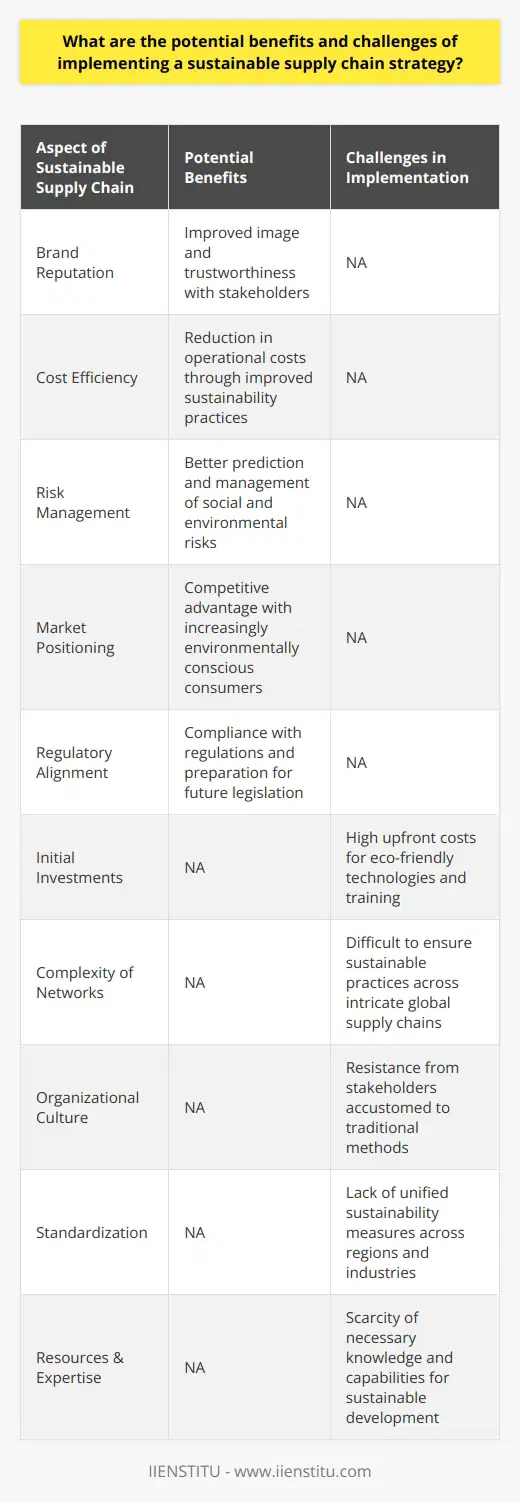
What are the main components of an efficient supply chain management system?
Efficient Supply Chain Components
An efficient supply chain management system encompasses critical elements such as planning, sourcing, production, management, and logistics to enable outstanding performance. The main components of an efficient supply chain management system are as follows:
Strategic Planning and Forecasting
One of the most critical aspects of supply chain management is strategic planning and forecasting. Accurate demand forecasting helps organizations estimate the required raw materials, inventory levels, and final products. Through efficient planning, businesses can improve customer service and reduce costs.
Sourcing and Procurement
Sourcing deals with the selection of suppliers who provide raw materials, products, and services. Efficient procurement ensures a steady supply of high-quality goods at competitive prices. A well-managed sourcing process is critical for maintaining profitability and reputation in the market.
Inventory Management
Inventory management involves tracking and controlling inventory levels, including raw materials, work-in-progress goods, and finished products. A system that provides visibility and control over inventory levels ensures timely deliveries and prevents stockouts or overstock situations, optimizing overall costs.
Production and Manufacturing
Efficient production is crucial for meeting customer demand. A streamlined manufacturing process enables organizations to produce goods quickly, consistently, and cost-effectively. It includes activities such as production planning, scheduling, and quality control that contribute to delighting customers with reliable products.
Logistics and Distribution
Efficient logistics and distribution entail delivering the right product, at the right place, and at the right time. This aspect focuses on transportation, warehousing, and last-mile delivery. A well-coordinated distribution network enables businesses to fulfill orders promptly and maintain high customer satisfaction levels.
Integration and Collaboration
Lastly, integration and collaboration among supply chain members play a vital role in achieving an efficient supply chain management system. Utilizing information technology and communication tools, organizations can share data, coordinate actions, and work together to optimize supply chain operations.
In conclusion, an efficient supply chain management system requires strategic planning, sourcing, inventory management, production, logistics, and collaboration among stakeholders. These components work together to ensure an organization consistently meets customer demands, maintains high levels of customer satisfaction, and remains competitive in the market.
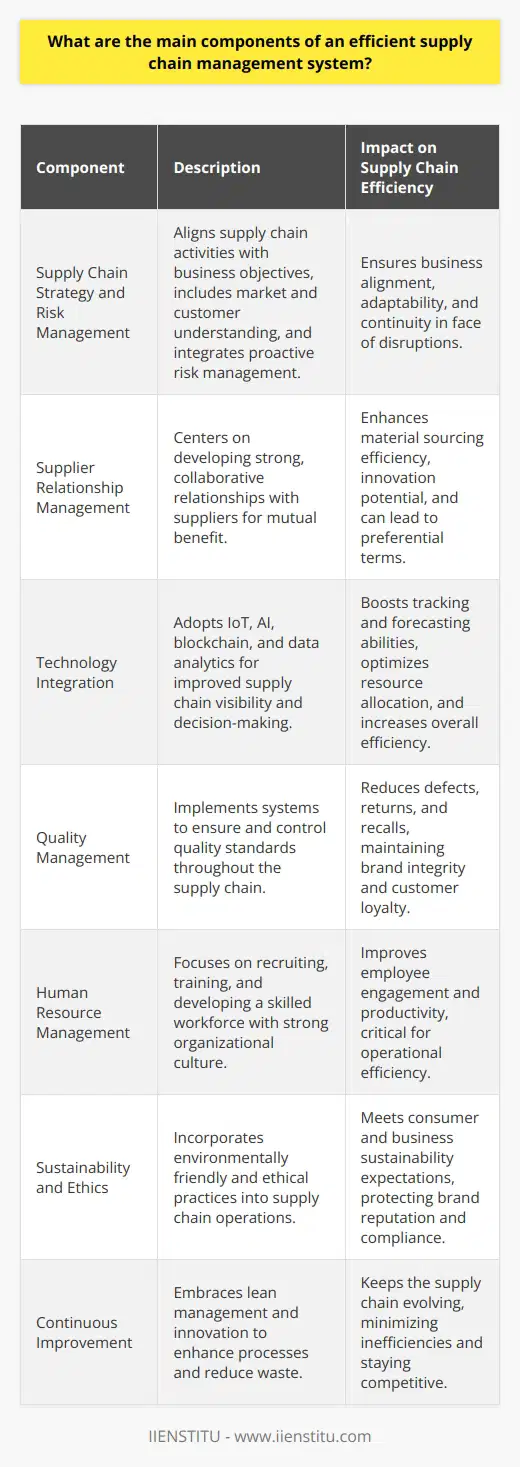
How can a company leverage collaborative planning, forecasting, and replenishment strategies to improve supply chain optimization?
Effective Collaboration Strategies
A company can enhance supply chain optimization through collaborative planning, forecasting, and replenishment (CPFR) strategies by integrating various business processes and shared data within the organization and with outside partners. This alignment leads to improved decision-making processes, increased responsiveness, and reduced operational costs.
Data Sharing and Standardization
In order to make informed supply chain decisions, relevant and accurate data must be shared between all stakeholders in a timely manner. By implementing standardized data models and communication protocols, companies can ensure that everyone involved in the supply chain has access to consistent, high-quality information. This supports precise forecasting and facilitates inventory management, thereby optimizing supply chain operations.
Synergistic Planning Process
Collaborative planning is crucial for supply chain optimization, as it enables stakeholders to align their objectives and synchronize their activities. By engaging in joint demand and supply planning, companies can forecast more accurately and balance demand fluctuations with supply availability. Through collaboration, companies can also leverage shared resources and expertise to develop innovative strategies that drive optimal functioning of supply chains.
Real-time Replenishment
Implementing CPFR strategies enables quicker response times to changes in consumer demand or market conditions. By incorporating real-time data and predictive analytics into the replenishment process, organizations can ensure that stock levels are maintained appropriately, avoiding both stockouts and excess inventory. This can significantly reduce logistics costs while also improving customer satisfaction levels.
Continuous Improvement
Optimizing supply chain operations requires ongoing monitoring and analysis of key performance indicators (KPIs) to identify inefficiencies. By leveraging shared insights and encouraging a culture of continuous improvement, companies can refine their CPFR processes and drive towards further supply chain optimization. Adopting a feedback-based approach enables organizations to stay agile and adapt to evolving market trends and consumer preferences.
Conclusion
Overall, leveraging collaborative planning, forecasting, and replenishment strategies can significantly contribute to supply chain optimization. These strategies promote synergized decision-making, demand-supply balance, and swift responsiveness, ultimately enhancing operational efficiency and customer satisfaction. Embracing a shared, data-driven, and continuous improvement approach is essential for success in today's dynamic and ever-evolving market landscape.
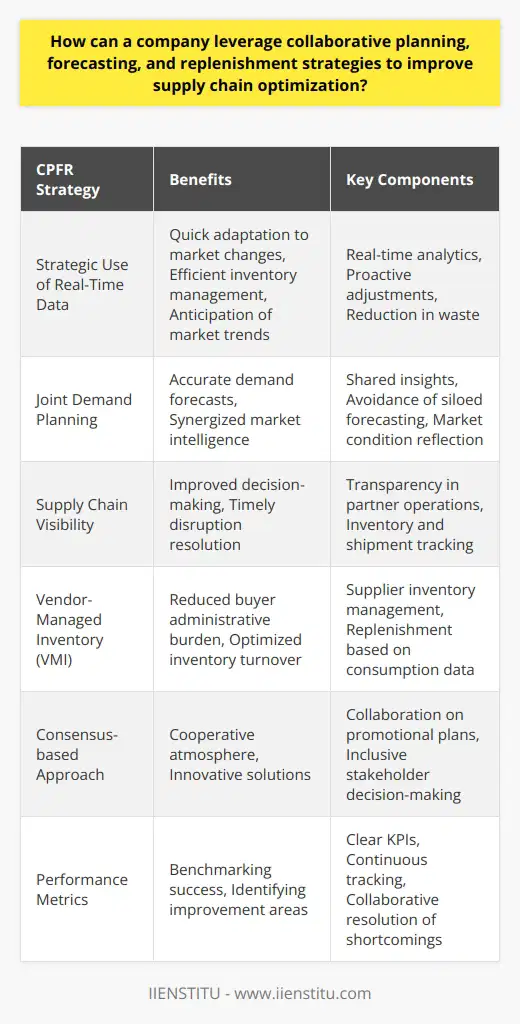
What steps can organizations take to develop a responsive and agile supply chain in an increasingly competitive business environment?
Assessing Supply Chain Risks
To create a responsive and agile supply chain, organizations must start by assessing potential risks and vulnerabilities in their network. By identifying and prioritizing these risks, businesses can develop strategies to mitigate them and prevent disruptions.
Adopting Innovative Technologies
Leveraging advanced technologies like artificial intelligence, machine learning, IoT, and data analytics can provide organizations with better visibility and real-time information on their supply chain performance. By adopting such innovations, businesses can make more informed and proactive decisions to optimize their operations.
Strengthening Supplier Relationships
Establishing strong, collaborative relationships with suppliers can significantly contribute to developing a responsive and agile supply chain. Open communication, sharing of information, and joint problem-solving initiatives can lead to better risk management and improved overall performance.
Implementing Demand-Driven Planning
To stay competitive, organizations need to shift their focus from traditional supply-driven models to demand-driven planning. By closely monitoring customer demand and adjusting production schedules accordingly, businesses can better match their supply chain operations with market needs and reduce inventory levels.
Embracing Supply Chain Visibility
Enhancing supply chain visibility is critical for organizations to better manage and coordinate their operations in a competitive environment. By implementing digital tools and platforms that provide end-to-end visibility, businesses can make timely and informed decisions to enable quick responses to disruptions or changes in the market.
Developing a Flexible Workforce
A skilled and flexible workforce is essential for organizations to adapt quickly to changes in the competitive landscape. Employing cross-functional teams, providing ongoing training, and offering career development opportunities can help organizations build a capable and adaptable workforce to support supply chain resilience.
Investing in Continuous Improvement
Organizations should prioritize continuous improvement initiatives to refine their supply chain processes and identify opportunities for cost reduction and efficiency gains. By fostering a culture of improvement and innovation, businesses can remain agile and responsive to market needs while maintaining a competitive edge.
In conclusion, developing a responsive and agile supply chain requires organizations to proactively address potential risks, embrace cutting-edge technologies, cultivate strong supplier relationships, and focus on continuous improvement. By adopting these strategies, businesses will be better equipped to navigate the challenges of an increasingly competitive business environment and maintain a resilient supply chain.
